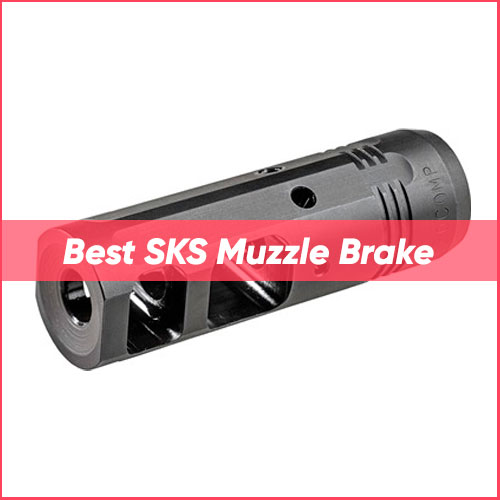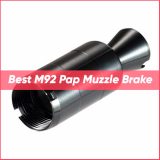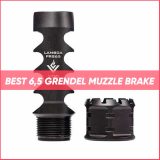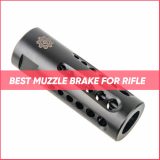Best SKS Muzzle Brake 2024
What is SKS Muzzle Brake? 😏 It is a firearm accessory designed to reduce the felt recoil of a weapon by redirecting the propellant gases released from the muzzle. It is…
Muzzle brake is a device that is fitted to the muzzle of a firearm to redirect propellant gasses to counter recoil and unwanted rising of the barrel during firing. When shooting a rifle, for example, the muzzle brake can be very effective in reducing the amount of felt recoil. Additionally, muzzle brakes can be used to reduce the muzzle rise that often occurs when firing a handgun.




Many muzzle brakes on the market today are made from high-quality materials such as stainless steel or titanium. Some even feature a self-cleaning design that helps to prevent carbon buildup on the device. Muzzle brakes are an essential piece of equipment for many shooters and can be found on both rifles and handguns.
If you are looking for a way to improve your shooting experience, then a muzzle brake may be the perfect solution for you. Browse our reviews of muzzle brakes below and find the perfect one for your needs.
There are many benefits to installing a muzzle brake on your firearm. Perhaps the most obvious benefit is the reduction in felt recoil. This can be a huge help when trying to stay on target for follow-up shots, or when shooting larger caliber weapons. Muzzle brakes can also help reduce muzzle rise, which can again help you stay on target and improve your accuracy.
Another big benefit of muzzle brakes is that they can help reduce the report of your firearm. This is especially important for hunters who need to worry about spooking the game, or for shooters who are using suppressors. By redirecting some of the gases away from the shooter, muzzle brakes can make your firearm much more pleasant to shoot.
There are two main types of muzzle brakes: linear compensators and porting.
Which type of muzzle brake is right for you will depend on your individual needs and preferences. If you’re looking for maximum recoil reduction, then a linear compensator is probably your best bet. However, if you’re worried about the added noise of a linear compensator, then a ported muzzle brake might be a better option.
A muzzle brake or recoil compensator is a device connected to, or a feature integral to the construction of, the muzzle of a firearm that redirects propellant gases to counter recoil and unwanted muzzle rise. They have been used in firearms for as long as they have been around.
Early muzzle brakes were simply large boreholes drilled into the barrel following the rifling. This device was effective at reducing both recoil and muzzle rise but had a major disadvantage in that it also vented gas and noise to the side, making it unpopular with soldiers.
Today, muzzle brakes are an essential part of many firearms, including rifles, pistols, and shotguns. They are also used on some large caliber weapons such as mortars and howitzers. Muzzle brakes are available in a variety of designs, but all serve the same purpose; to reduce recoil and muzzle rise.
No matter which type of muzzle brake you choose, you’re sure to see an improvement in your shooting. So if you’re looking to take your shooting to the next level, be sure to check out some of the best muzzle brakes on the market!
What is SKS Muzzle Brake? 😏 It is a firearm accessory designed to reduce the felt recoil of a weapon by redirecting the propellant gases released from the muzzle. It is…
What is M92 PAP Muzzle Brake? 😏 It is an accessory that is designed for M92 PAP (Serbian M92) assault rifles, which are based on the AK-47 design. This muzzle brake…
What is a 6.5 Grendel Muzzle Brake? 🔍 6.5 Grendel Muzzle Brakes are a type of muzzle device used to reduce recoil and help increase accuracy when shooting 6.5 Grendel…
What is a muzzle brake for a hunting rifle? 🧐 It is a device attached to the end of a barrel that redirects exiting gasses generated by firing. This helps…
What is a Titanium Muzzle Brake? ☄️ A titanium muzzle brake is a device that is attached to the end of a firearm barrel to reduce recoil and muzzle rise.…
What is Muzzle Brake for 7mm Rem Mag? 🧐 It is a device that is designed to reduce the recoil of firearms by redirecting the gases produced when a gun…
What is Vepr 12 muzzle brake? 🧐 It is a muzzle device designed to reduce the recoil and muzzle rise experienced when firing your Vepr 12 shotgun. It achieves this…
What is Glock 17 Muzzle Brake? 💡 It is an accessory designed for Glock 17 handguns. It serves to reduce recoil and muzzle climb by dissipating the gases generated from…
What is Mosin Nagant's muzzle brake? 🤔 It is an accessory designed to reduce muzzle rise and recoil on popular Mosin Nagant rifles. The brake works by redirecting the blast…
What is Noise Reducing Muzzle Brake? 💡 They are designed to reduce the loud report of a firearm, allowing shooters to practice shooting in close quarters without disturbing others or…
What is Muzzle Brake For Long Range Shooting? 🔍 💣 A muzzle brake for long-range shooting is a device that is attached to the end of the barrel of a…
What is Muzzle Brake for 350 Legend? 🔍 A muzzle brake is a device attached to the end of a firearm's muzzle that helps reduce felt recoil and muzzle rise.…
What are 5.56 Muzzle Brakes? 🤨 They are devices that attach to the end of a rifle barrel. They are designed to reduce recoil and muzzle rise when firing a…
What is 458 Socom Muzzle Brake? 😏 It is a type of recoil-reducing accessory designed for rifles chambered in the 458 SOCOM cartridge. It works by redirecting gases that exit…
What is 223 Muzzle Brake? 🧐 They are designed to reduce recoil on firearms chambered for .223 caliber cartridges. These brakes work by redirecting gas from the barrel through ports…
What is 50 Beowulf Muzzle Brake? 🔍 The .50 Beowulf is a powerful rifle cartridge designed for use in AR-15-style rifles. A muzzle brake is a device attached to the…
What is Muzzle Brake For 300 Win Mag? 🔔 It is a device that is attached to the end of the rifle's barrel to redirect the gases produced when a…
What is a 5/8-24 Muzzle Brake? 🤔 It is a device that helps to reduce the recoil and muzzle rise of a firearm when shooting. It does this by redirecting…
What is a 30-cal muzzle brake? 🧐 It is a firearm attachment that helps to reduce recoil when firing. It works by redirecting the gases produced by the burning of…
What is a 9mm muzzle brake? 🧐 It is a device that helps to reduce felt recoil when firing your favorite firearm. It works by redirecting the pressure and gases…
⚫️ AR-10 Muzzle Brake is... ⇢ a device attached to the end of the barrel of an AR-10 rifle that helps to reduce recoil and muzzle rise. ♻️ It works…
What is Muzzle Brake for 7.62x39? 🔔 It is an attachment for firearms that works to reduce the amount of felt recoil and muzzle jump when firing. It does this…
What is AK Muzzle Brake? 🔍 ⇢ The AK Muzzle Brake is a firearm accessory designed for use with AK-47 rifles and other firearms that have similar threading on the…
What is 308 Muzzle Brake? 🤔 It is a device that redirects the high-pressure gases created by firing a 308 rifle round to reduce recoil. It does this by directing…
What is an AR-15 Muzzle Brake? 🔔 It is an accessory attached to the barrel of an AR-15 rifle that helps reduce the recoil and muzzle rise associated with firing.…
What is 450 Bushmaster Muzzle Brake? 💡 It is a muzzle device designed to reduce recoil, stabilize the barrel’s direction of fire and help keep the gun on target during…
What is muzzle brake 6.5 Creedmoor? 🧐 It is a type of firearm device that helps reduce the felt recoil and muzzle rise when firing a rifle chambered in the…
What are Muzzle Brakes Clamps? 🔔 Muzzle Brakes are devices that are attached to the end of a firearm's barrel to reduce the amount of recoil and muzzle rise produced…
What are muzzle brakes? 🤔 They are rifle accessories designed to reduce felt recoil, muzzle rise, and other characteristics of shooting. They usually attach to the end of a gun…